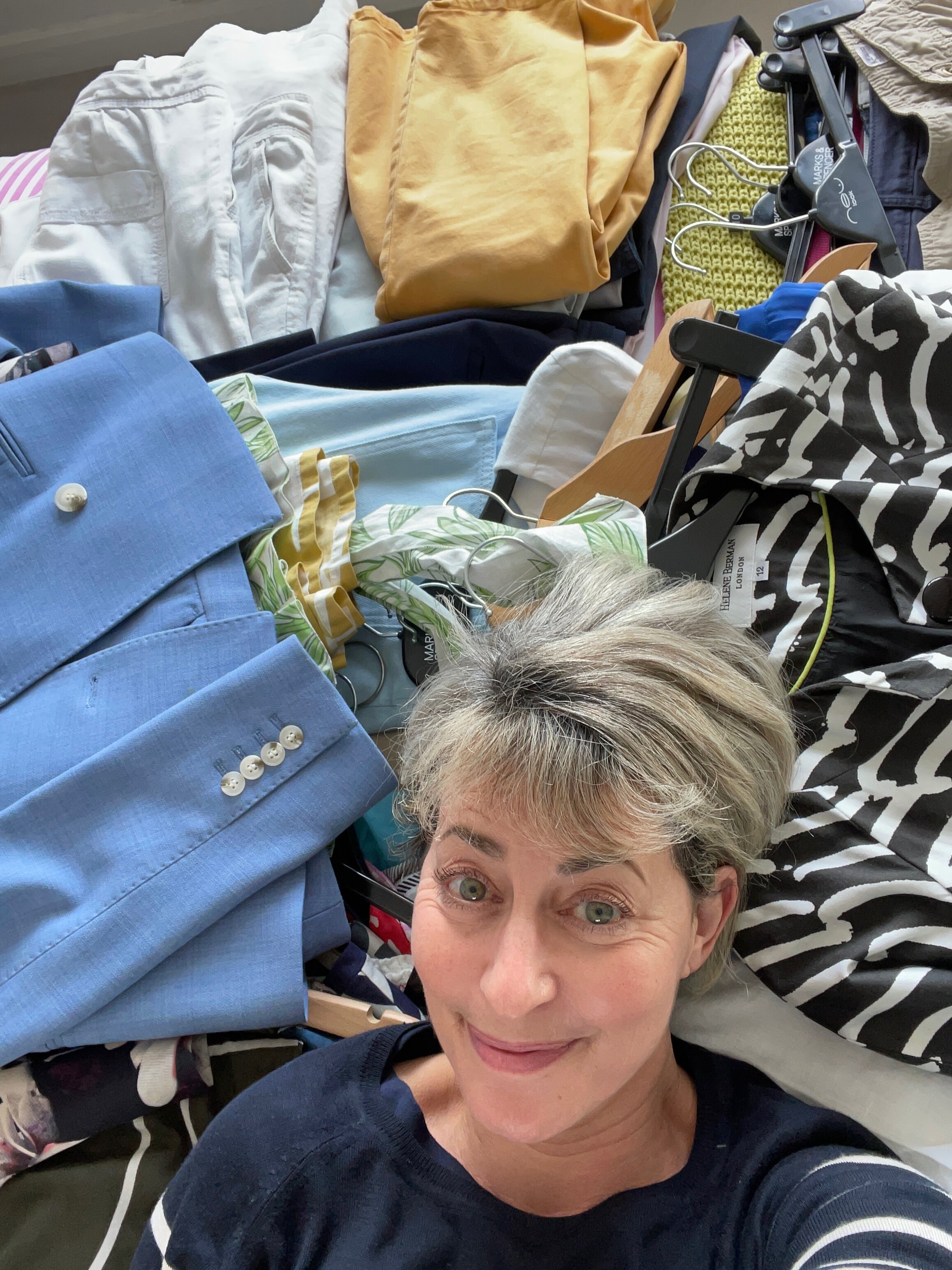Your season changeover clothes care guide
What with it being that time of year when, if you’re anything like me, you’re finally changing over your summer clothes for your autumn/winter ones, I thought it was a good moment to share with you some of the clothes care tips that I’ve used over the years, as well as some that are newer to my wardrobe maintenance schedule.
This is always one of two points in the year (the other being the change back from my chilly weather attire to my optimistically warm weather items) when I’m made uncomfortably aware of how many clothes I have. It’s unquestionably too many. Although thanks to a now rigidly applied rule of one-in-one-out (if I buy anything new, at least one other thing has to go to the charity shop. It’s surprising how much it makes you consider your purchases) and tip two on the list below, it’s less too many than it has been in the past (that’s definitely not proper English, but you get what I mean).
Before I crack on with that list - this won’t take a moment, we’ll get there right after this, I promise - I should, for the sake of accuracy, point out that not all the tips are strictly clothes care related. Some are about other aspects of wardrobe management, but they feel relevant and, I hope, useful to include.
Get it all out
When it comes to this change of season change-over, and at the risk of stating the bleeding obvious, the first thing to do is to take out all the clothes you’re going to be putting away. That way you can clearly see what you’re going to need to pack, or hang, up.
Sort it all out
This is the ideal time to do an audit of your clothes - when you really can see all of them. I sort mine into three piles. The ones I’m hanging on to, the ones it’s time to part with, and the ones that need some kind of attention.
The items that make it into the first pile should only really be things you’ve worn at least once, and ideally many times more, in the past season. Though, of course, with the times we’ve all lived through these last months, there will be items that won’t have seen the light of day simply because you haven’t either. They get a free pass this time.
Pile two should consist of all those pieces that you’ve fallen out of love with, that somehow seem to have, er….shrunk mysteriously (unless you’re a serial weight yo-yo’er, force yourself not to hang on to them just in case), that are strangely similar (for which read virtually identical) to several other items (how many pairs of blue trousers does any one person need?) or that seemed like a good idea at the time, but really weren’t (be honest now).
These are the things to donate to a worthwhile charity (do make sure they’re clean and in good condition first and, speaking from many narrowly-avoided unfortunate incidents, do check all the pockets to make sure they’re empty). I’ve given all my recent clothes donations to a local charity that’s helping Afghan refugees. It feels like a small thing to do for people who are going through such terrible hardship.
And pile three are all the items that need to be washed, ironed or mended before they’re stored away for the winter.
With the fashion industry being responsible for 10% of all global emissions, I do believe it’s beholden on us all to try to buy less - across the board, but certainly when it comes to clothes. So this is also the pile to put anything you think you might be able to alter, or which, with a bit of tlc, could have its useful life extended. (Tips for that coming up)
Choose the right storage for your space
There are about a bazillion (I’m only exaggerating slightly) storage options you can choose from for your keep-these items, from zip up bags of every conceivable shape and size, to thousands of different size storage boxes in every material from plastic to hessian. The trick is to work out what fits in the space you have and, well…use that.
Ideally don’t over fill whatever boxes or bags you’re using. It can cause hard-to-remove creases.
And if you’re worried about moths, I find cedar balls the least toxic and most effective way of keeping them at bay.
I happen to have enough spare hanging space to keep all my hanging items on their hangers. But before I put them away, I make sure everything is hanging evenly on the hangers, all buttons and zips are done up, and all belts are secure. It helps the items to emerge from their winter hibernation looking presentable.
But don’t do this
Don’t cover hanging items with plastic dry cleaner bags. They stop the clothes from being able to breathe properly, which they need in order to not to become fusty and even get mildew.
Although vacuum bags can be a good idea for some items, don’t be tempted to use them for anything ‘fluffy’ like puffa jackets or thick coats (I realise they’re winter items so that doesn’t apply at this time of year) or anything made of leather, wool, silk or cashmere. The natural fibres in these clothes can be permanently damaged by being compressed for long periods.
And if you happen to hang any sweaters and cardigans for easy access, fold, rather than hang, those for over-season storage. They’ll keep their shape much better.
Oh, and this is a personal bug-bear of mine, so I make no apologies for sounding a bit dictatorial - don’t use wire hangers. Ever. For anything. They’re no good for your clothes - they cause them to sag more than they should, they don’t properly support the weight of anything heavy, and they bend/bow over time. These are all Bad Things For Your Clothes.
Top washing tips
For any of those items in the washing pile, these are my top three tips for getting them (and indeed all your clothes) clean most effectively and eco-efficiently.
Tip One
Wash them at a cooler temperature than you think. Nothing needs washing at more than 40C and almost everything will come up perfectly clean at 30C. And never use fabric conditioner or softener. It coats your clothes with silicone, cutting their absorbency by up to 80 per cent, fills the spaces between yarns so clothes can’t breathe and makes stains incredibly hard to shift.
Tip Two
Only ever use the speed wash setting. This is a relatively new revelation for me, but it turns out that what’s bad for the planet, is also bad for your clothes. It’s another of those bleeding obvious statements that a one or two hour wash uses far more energy than one that’s shorter, but it’s also kinder for your clothes because they’re being tossed around in soap and water for less time. And they come out exactly as clean as they would on a longer wash.
Tip Three
If you’re washing any wool or silk items, turn each one inside out and put it in a mesh bag, something like these, one item per bag. If the bag is too big, fold it over and fasten the mesh in place with safety pins. Wool items should be folded, rolled and stuffed tightly like a giant sausage in the mesh bag – if necessary fold over and secure with safety pins to make the bag fit more snugly. This stops them rubbing against other clothes in the machine, which is what makes them matt and emerge smaller. Once they’re bagged, they can be washed with everything else on the 30C speed wash.
Bonus drying tip
Ideally - for the environment and your clothes - you should air dry everything, but if you need to use a drier, a tightly rolled ball of tin foil will remove any static from the clothes. It’ll get slightly smaller with each cycle, so when it’s about the size of a golf ball - which will take about 60 cycles - replace it.
You’ll find loads more terrific laundry/clothes care tips in the brilliant book How to Love Your Laundry: Sort your smalls, save the planet and never dry clean anything again
Care and repair
Even the most sewing-incompetent amongst us can manage simple repairs like sewing on buttons or hooks (you can, you really can). But if your items need more attention than that, try the website Love Your Clothes, it has hundreds of easy to follow care and repair instruction videos as well as loads of great ideas and advice for buying, refashioning and passing on your clothes. There are also a wide range of excellent DIY tutorials on repairwhatyouwear
Or find a local service that will do the repairs or alterations you want for you.
Knowing that over 3500,000 tonnes of clothes being tipped into landfill sites each year, is a great incentive to give what we wear the longest useful life possible.
I always feel a twinge of melancholy when it comes to putting away my summer clothes, much as I enjoy the cool crisp days of autumn. But I also welcome the chance to rediscover the warmer wear I’ve had hidden away all those months. And that has hopefully emerged in pristine condition thanks to a little time and attention spent packing it up in the best way possible.
Please do share your favourite clothes packing, care, fixing or alteration tips in the comments below.
Other posts you’ll enjoy
9 ways to declutter and save the planet





